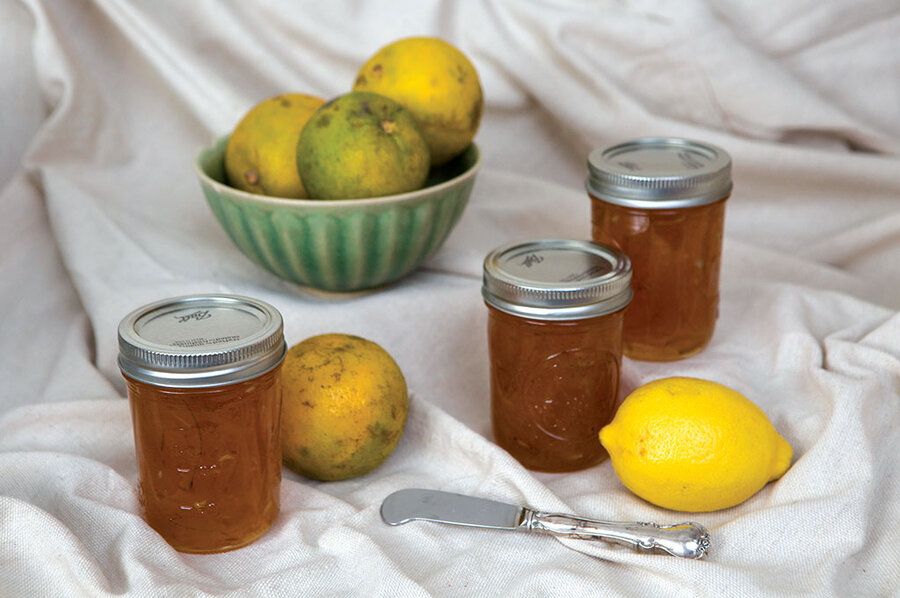Marmalade worthy of Paddington Bear
Loading...
I am fairly sure there is no special handshake for the mystical fraternity of marmalade-makers. But perhaps there should be. We are a breed apart. When we admit, modestly, that we practice the art, we usually elicit an impressed intake of breath. Except, of course, from those who find this comestible just too bitter to contemplate.
There are relatively sweet orange so-called marmalades, but those of us in the know would argue these won’t do at all. The real McCoy must have at least a slight wince factor. A tang. There are historical – though some would say “apocryphal” – reasons for this. Either way, marmalade’s origin is a good story: At the end of the 18th century, a foundering ship with a cargo of bitter, thick-skinned oranges from Seville, Spain, discharged its load in the Scottish Port of Dundee. The fruit was damaged (not to mention its recently acquired sea-saltiness), but the ship’s captain shook hands on a deal with a local Dundee man who purchased the oranges at a competitive price.
The man’s wife thriftily spotted an opportunity and proceeded to slice up the citric skin to bulk out her homemade orange jam. Her neighbors were not unimpressed. The rind was rigorous on the tongue and a widening range of discerning breakfasters across the land found it a stimulating start to the day, particularly when spread on buttered toast.
Marmalade’s popularity increased, becoming for years as de rigueur for an English breakfast as kippers, prunes, and porridge. Now all sorts of things are considered feasible for breakfast, and marmalade is just one among many. In hotels, if you ask for marmalade, they offer you tiny plastic containers of pink or black jelly. Even if it’s orange, it’s likely to be apricot. Real marmalade, made from Seville oranges, is becoming a rarity.
A small glimmer of marmalade hope, however, is due to an enthusiastic bear. Not Winnie-the-Pooh, obsessed with honey. The bear in question came from darkest Peru as a stowaway and arrived as a refugee on a London rail station platform: Paddington Bear. In his suitcase was a jar of ... marmalade. A 2014 film about Paddington featured marmalade prominently. Apparently marmalade sales have increased, thanks to that.
I should mention that there are other claimants to the initial invention. Oxford, England, is sometimes suggested as the birthplace of marmalade. Even now these rival geographies continue to market marmalade successfully. A great variety of flavors and textures exist, all called marmalade, each having its advocates. Oranges, lemons, limes, grapefruits, mandarins, kumquats, bergamots, and maybe quinces are marmaladable, it seems. The fact that marmalades are made of citric fruit and include sliced peel distinguishes them from other jams and jellies. “Strawberry marmalade,” then, is a contradiction in terms.
But there is an agreement among cognoscenti that no commercially available marmalade holds a candle to homemade. I am not sure why. Economical shortcuts? Preservatives? The labor-intensiveness of making it at home may be the explanation. It’s very hard work. But the result is irresistible.
Orange marmalade
Yield: 10 eight-ounce jars
You’ll need jars, lids, and rings; a 12-quart canner with a rack; a candy thermometer; and some previous experience with canning. A jar funnel and jar lifter are very useful, and this is practically impossible to do without a mandoline to slice the oranges thin enough. Strive to find Seville oranges; their brief season is from December to February.
1-3/4 pounds Seville oranges (or substitute juice oranges), about 5 medium
Juice and finely grated zest of 1 lemon
3-3/4 pounds sugar
PREPARATION: Lightly scrub oranges and lemon with warm water. Cut oranges into 1/8-inch slices. Discard seeds. Stack slices and cut into quarters. Add to six-quart nonreactive pot with lemon juice, zest, and six cups of water. Bring to a boil and then reduce to a rapid simmer for 40 minutes. As the oranges simmer, fill canner three-quarters full of water and bring to a boil. Add jars and rings (not lids) and boil for 10 minutes. Turn off heat; add lids.
When oranges have simmered long enough, bring to a rapid boil and stir in sugar. Now it’s a matter of hitting the right temperature: 222 degrees F. Stir frequently and adjust heat to avoid boiling over. This can take as long as 30 minutes.
Once the mixture reaches 222 degrees F., turn off heat. Quickly drain jars and set them on a dishtowel. Using a ladle and a jar funnel, fill jars to just below the threads. Wipe off the rims and then, using tongs, fish the lids out of the canner and set them atop the jars. Screw the rings finger tight. Bring water in the canner to a boil again and process filled jars for 10 minutes. Remove and let cool. Check jar seals. Wait 24 hours before serving.







